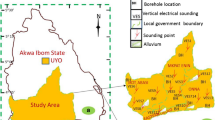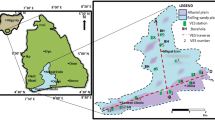Abstract
An electrical resistivity method has been used to determine aquifer parameters in the Ganga-Yamuna interfluve in northern India. An existing relationship between the geoelectrical and hydraulic parameters has been modified for the case of an anisotropic aquifer. The hydrogeological framework in the upper part of the Ganga-Yamuna interfluve is evaluated by using existing relationships between hydraulic parameters and geoelectrical parameters for alluvial aquifers. On the basis of aquifer geometry, the area has been divided into two hydraulic units: the western Yamuna flood plain and the Ganga flood plain towards the east. The resistivity data collected in parts of the study area are first interpreted in terms of true resistivity and thicknesses of subsurface layers. The electrical parameters (resistivity and thicknesses) are subsequently correlated with the available pumping test data. Distinct correlations between transmissivity and modified transverse resistance are obtained for the two hydraulic units. A four-parameter model consisting of hydraulic conductivity, modified longitudinal resistivity, modified transverse resistance and hydraulic anisotropy is presented for the anisotropic aquifer underlain by conductive fine grained sediments. The model has been validated at a number of locations, where aquifer parameters are known from pumping test data.
Résumé
Une méthode électrique de résistivité a été employée pour déterminer les paramètres hydrodynamiques de l’aquifère d’interfluve dans le Gange-Yamuna dans le Nord de l’Inde. Un rapport existant entre les paramètres geoélectriques et hydrauliques a été modifié pour le cas d’une couche aquifère anisotrope. Le cadre hydrogéologique dans la partie supérieure de l’interfluve Ganga-Yamuna est évalué en employant des rapports existants entre les paramètres hydrauliques et les paramètres geoelectriques pour les couches de l’aquifère alluvial Sur la base de la géométrie de la couche aquifère, le secteur a été divisé en deux unités hydrauliques : la plaine inondable occidentale de Yamuna et la plaine inondable du Gange vers l’est. Les données de résistivité du secteur d’étude rassemblées en partie sont d’abord interprétées en termes de résistivité réelle et d’épaisseur des couches de surface Les paramètres électriques (résistivité et épaisseurs) sont ensuite corrélés avec les données disponibles des pompages d’essai. Des corrélations distinctes entre la transmissivité spécifique et la résistance transversale modifiée sont obtenues pour les deux unités hydrauliques. Le modèle constitué de 4 paramètres : conductivité hydraulique, résistivité longitudinale modifiée, résistance transversale modifiée et anisotropie hydraulique est présenté pour un aquifère anisotrope souligné par des sédiments à grains fins conducteurs. Le modèle a été validé à un certain nombre d’endroits, où les paramètres de l’aquifère sont connus par des données de pompage d’essai.
Resumen
Un método resistividad eléctrica ha sido usado para determinar parámetros de un acuífero en el interfluvio Ganga-Yamuna en el Norte de la India. Se ha modificado una relación existente entre los parámetros hidráulicos y geoeléctricos para el caso de un acuífero anisótropo. El marco hidrogeológico en la parte superior del interfluvio de la Ganga-Yamuna es evaluada usando las relaciones existentes entre parámetros hidráulicos y geoeléctricos para acuíferos aluviales. Sobre la base de la geometría del acuífero, el área ha sido dividida en dos unidades hidráulicas: la planicie de inundación Yamuna hacia el oeste y la planicie de inundación Ganga hacia el Este. Los datos de resistividad recolectados en el área estudiada interpretados en primer lugar en términos de resistividad verdadera y espesor de capas subsuperficiales. Los parámetros eléctricos (resistividad y espesor) son subsecuentemente correlacionados con los datos disponibles de ensayos de bombeo. Se obtuvieron distintas correlaciones entre transmisividad y resistividad transversal modificada para las dos unidades hidráulicas. Un modelo de tetraparamétrico consistente de conductividad hidráulica, resistividad longitudinal modificada, resistividad transversal modificada y anisotropía hidráulica se presenta para el acuífero anisótropo subyacente a sedimentos granulares finos conductivos. El modelo ha sido validado en varias localidades, donde los parámetros del acuífero son conocidos a partir de ensayos de bombeo.
应用电阻率法确定了印度北部恒河
贾木那河河间地块的含水层参数. 修正了现有的各向异性含水层地电参数与水力参数间的关系式. 应用现有的冲积含水层水力参数与地电参数的关系评价了恒河-贾木那河河间地块上部的水文地质结构. 根据含水层的几何形态将研究区划分为两个水力单元: 西部贾木那河洪积平原和东部的恒河洪积平原. 分区收集了研究区的电阻率数据, 首先解译出真电阻率和地层厚度. 随后, 将电参数 (电阻率和厚度) 同现有的抽水试验资料相联系, 得到了两个水力单元导水系数和修正的横向电阻之间的显著相关关系。为该下伏导电细粒沉淀物的各向异性含水层建立了一个四参数模型, 包括渗透系数、修正纵向电阻率、修正横向电阻率和水力非均质性. 该模型已在多个地点得到标定, 其含水层参数皆由抽水试验资料得出.
Resumo
Um método de resistividade eléctrica tem sido usado para determinar parâmetros do aquífero no interflúvio Ganga-Yamuna, no norte da Índia. A relação existente entre os parâmetros geoeléctricos e hidráulicos foi modificada para o caso de um aquífero anisotrópico. O quadro hidrogeológico na parte superior do interflúvio Ganga-Yamuna é avaliado usando relações existentes entre os parâmetros hidráulicos e parâmetros geoeléctricos para aquíferos aluvionares. Em termos da geometria do aquífero, a área foi dividida em duas unidades hidráulicas: a ocidente a planície aluvial de Yamuna e a leste a planície aluvial de Ganga. Os dados da resistividade obtidos em zonas da área de estudo são inicialmente interpretados em termos da resistividade eléctrica real e das espessuras das camadas subsuperficiais. Os parâmetros eléctricos (resistividades e espessuras) são, posteriormente, correlacionados com os dados disponíveis de ensaios de bombeamento. São obtidas correlações distintas entre transmissividade e resistência transversal aparente para as duas unidades hidráulicas. Um modelo de quatro parâmetros, consistindo na condutividade hidráulica, resistividade longitudinal aparente, resistência transversal aparente e anisotropia hidráulica é apresentado para o aquífero anisotrópico subjacente constituído por sedimentos granulares finos. O modelo foi validado numa série de locais, onde os parâmetros do aquífero são conhecidos através de dados de ensaios de bombeamento.






Similar content being viewed by others
References
Bhatnagar NC, Agashe RM, Sikha VM (1977) Water balance studies in Upper Yamuna River basin. Technical report no. 9, Ministry of Irrigation, Govt. of India, Central Ground Water Board, Chandigarh, 139 pp
Boulton NS (1963) Analysis of data from non-equilibrium pumping tests allowing for delayed yield from storage. Proc Inst Civil Eng 26:469–482
Cooper HH, Jacob CE (1946) A generalized graphical method for evaluating formations constants and summarizing well field history. Am Geophys Union 27:526–534
de Lima OAL, Sato HK, Sri Niwas (2001) Mathematical modeling and simulation of electrical current density distribution in aqwuifer settings. In: Proceedings of the International Congress of Brazilian Geophysical Society, Salvador, Brazil, October 2001
Kelly WE (1977) Geoelectric sounding for estimating aquifer hydraulic conductivity. Ground Water 15(6):420–425
Kelly WE, Reiter PF (1984) Influence of anisotropy on relations between electrical and hydraulic properties. J Hydrol 74:311–321
Kosinski WK, Kelly EW (1981) Geoelectric sounding for predicting aquifer properties. Ground Water 19:163–171
Maillet R (1947) The fundamental equations of electrical prospecting. Geophysics XII(4):529–556
Mazac O, Landa I (1979) On the determination of hydraulic conductivity and transmissivity of granular aquifer by vertical electrical sounding. J Geol Sci 16:123–139
Mazac O, Kelly WE, Landa I (1985) A hydrogeophysical model for relations between electrical and hydraulic properties of aquifers. J Hydrol 79:1–19
Neuman SP (1972) Theory of flow in unconfined aquifers considering delayed response of the water table. Water Resour Res 8:1031–1045
Orellana E, Moony AM (1966) Master curve and tables for vertical electrical sounding over layered structures. Interciencia, Escuela, Spain
Pandey MP, Raghava Rao KV, Raju TS (1963) Ground water resources of Tarai-Bhabar belts and intermontane Doon valley of western Uttar Pradesh. Exploratory Tubewells Organisation, Ministry of Food and Agriculture, Govt. of India, Chandigarh
Singhal DC, Sri Niwas (1983) Estimation of aquifer transmissivity from surface geoelectrical measurements. Proc. UNESCO Symposium on Methods and Instrumentafion of Investigating Groundwater System, Noordwijkerhout, The Netherlands, May 1983, pp 405–414
Singhal DC, Sri Niwas, Shakeel M, Adam EM (1998) Estimation of hydraulic characteristics of alluvial aquifers from electrical resistivity data. J Geol Soc India 51:461–470
Sri Niwas, Singhal DC (1981) Estimation of aquifer transmissivity from Dar-Zarrouk parameters in porous media. Hydrology 49:393–399
Sri Niwas, Singhal DC (1985) Aquifer transmissivity of porous media from resistivity data. Hydrology 82:143–153
Sri Niwas, de Lima OAL (2003) Aquifer parameter estimation from surface resistivity data. Ground Water 41(1):94–99
Taylor GC (1950) Groundwater provinces of India. Econ Geol 54:683–697
Urish DW (1981) Electrical resistivity-hydraulic conductivity relationships in glacial outwash aquifers. Water Resour Res 17(5):1401–1408
Worthington PF (1976) Hydrogeophysical equivalence of water salinity, porosity and matrix conduction in erinaceous aquifers. Ground Water 14(4):221–232
Yadav GS, Abolfazli H (1998) Geoelectric soundings and their relationship to hydraulic parameters in semi arid regions of Jalore Northwestern India. J Appl Geophys 39:35–51
Zhdanov MS, Keller GV (1994) The geoelectrical method in geophysical exploration. Elsevier, Amsterdam
Acknowledgements
The authors are very grateful to the reviewers for critically reviewing the original manuscript and for giving relevant suggestions for improvement. The first author (RS) is grateful to Dr. S. Romani, former Chairman, Central Ground Water Board, Faridabad, for motivation with respect to the present study. Further, the authors are thankful to Mr. S.K. Malhotra, Executive Engineer, U.P. State Ground Water Department, Saharanpur for providing data. The authors also thank Dr. M.D. Nautiyal, Emeritus Fellow, Department of Hydrology, IIT Roorkee and Dr. Sri Niwas, Professor, Department of Earth Sciences, IIT Roorkee, for wide ranging scientific discussions on the paper.
Author information
Authors and Affiliations
Corresponding author
Rights and permissions
About this article
Cite this article
Sinha, R., Israil, M. & Singhal, D.C. A hydrogeophysical model of the relationship between geoelectric and hydraulic parameters of anisotropic aquifers. Hydrogeol J 17, 495–503 (2009). https://doi.org/10.1007/s10040-008-0424-9
Received:
Accepted:
Published:
Issue Date:
DOI: https://doi.org/10.1007/s10040-008-0424-9




